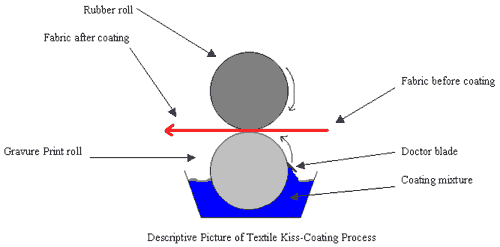
By: Frank Grace, Dr. Slocum, and Dr. Clapp

By
Frank C. Grace
TE 589A Theory of Inventive Problem Solving (TRIZ)
Fall 2000
Professors:
Dr. Michael Slocum &
Dr. Timothy Clapp
North Carolina State University College of Textiles
Preface:
The following paper summarizes a real industrial problem solving experience that was part of a graduate-level course. The course focused on an in-depth study of the fundamental principles of the Theory of Inventive Problem Solving. Each student selected a real problem to solve using the methods as part of the class. The algorithm, ARIZ - 85C, was used to guide the student systematically through the problem solving process. The following paper describes one student's experience applying TRIZ methods.
Introduction:
The topic for this paper involves a textile coating process known as kiss-coating. This process is currently being used where I work as a textile chemist. A water based adhesive, which is an emulsion, is fed into a trough until the trough is 75% full. Inside the trough an engraved gravure print roll turns. As the roll turns the engraved cells on the surface of the print roll fill with the coating mixture in the trough. A doctor blade cleans off excess coating that is on the printing roll and this excess coating mix is returned to the trough for reuse. Once the print roll is clear of excess coating mix, it then meets a rubber roll that is under downward pressure. The fabric passes in between the two rolls. As the fabric gets nipped between the print roll and the rubber roll, a slight vacuum is created and the coating mix leaves the cells on the print roll and transfer to the surface of the fabric. This particular coating process is used to obtain a surface coating rather than saturating the fabric with coating. The wet-coated fabric then wraps around heated drying cans to drive off the water on the coated fabric and leave behind the adhesive coating.
The Engineering Problem to be solved:
As in many operations, the line speed dictates the cost of a product. The faster a product is made the higher the production rate (units made per hours or shift) and therefore its cheaper to manufacture the product. The money saved by running at higher production rates turns into company profits or is sometimes passed onto the customer in an effort to remain competitive in the textile industry. The higher product rates also allow for an increase in machine production capacity, which is needed by most growing companies.
It was discovered in this operation in question that as the speed of the machine was increased, the coating weight decreased. This forced the product to be run through a two-pass operation or at a slower speed so that the desired coating weight could be achieved. The slower coating operation caused the production rate to go down and the faster two-pass operation had the same effect on the production rate.
What is needed is a method that allows for an increased production rate (faster coating speed) and at the same time provides a sufficient coating weight. ARIZ-85C will be used to solve this problem.
Initial concept solutions generated before applying TRIZ methodology:
Some of the initial ideas that were generated to solve this problem are as follows:
ARIZ 85C
1. Mini-Problem Formulating
1.1 Choose the Key Problem and render corresponding the Direct Key Knot:
|
1.2. Determine the Useful Function, its Product and Tool. Describe the Useful Function using typical wording:
|
Useful Function: |
Increase production rate |
|
Product: |
Coated fabric |
|
Tool: |
Coating assembly |
The coating assembly speed influences the amount of coating being applied to the fabric.
1.3. Determine the Harmful Function, its Product and Tool. Describe the Harmful Function using typical wording:
|
Harmful Function: |
Decrease in coating applied to fabric |
|
Product: |
Coated fabric |
|
Tool: |
Coating assembly |
The coating assembly does not apply enough coating to the fabric when its speed is increased.
1.4. Find out the Common Element(s) in the Useful and Harmful Functions:
The common elements in the useful and harmful functions are the coated fabric and the coating assembly.
1.5. Render the Graphical Scheme of the Conflict:
The faster coating head speed provides a Useful Function by increasing production rates but provides a Harmful Function by not applying enough coating.
| Very fast coating speed |  |
Production rate
Decrease of coating weight |
1.6. Discover from the Problem Description an additional condition such that both desired and undesired consequences in the Key Knot (Useful and Harmful Functions, respectively) are enhanced. Adjust the Key Knot wording with both considerations for this additional condition and changes in names of elements and functions after eliminating ‘professional’ terms:
|
1.7. Formulate the Functional Initial Contradiction IC-1 corresponding to the Direct Conflict:
IC-1: If the coating speed is exponentially increased then (+) very high production rates will be obtained but (-) the coating weight will be extremely low.
1.8. Render the scheme of the Reverse Key Knot:
If the coating line speed is decreased below normal running conditions (-) production output will be reduced below what is normally expected but (+) the coating weight will not drop below specifications.
1.9. Render the Graphical Scheme of the Reverse Conflict:
| Production rate |  |
Very slow Coating speed
Extremely low coating weight |
1.10. Formulate the Functional Initial Contradiction IC-2 corresponding to the Reverse Conflict:
IC-2: If the coating assembly is run at a slower than normal speed, then (+) the lower coating weight can be eliminated but (-) the production rate will drastically decrease.
1.11. Formulate the Mini-Problem:
There is a technical system for performing an increased coating speed, including a coating assembly and coated fabric.
IC-1: If the coating speed is exponentially increased then (+) very high production rates will be obtained but (-) the coating weight will be extremely low.
IC-2: If the coating assembly is run at a very slow speed, then (+) the lower coating weight can be eliminated but (-) the production rate will drastically decrease.
It is essential under minimum changes in the system to perform (+) an increased coating speed without (-) producing a fabric with a reduced coating weight.
2. The Pseudo-Fundamental Contradiction Formulating and Resolving
2.1. Formulate the Pseudo-Fundamental Contradiction (PFC):
The coating assembly should be operating to perform an increased coating speed and should also coat the fabric with sufficient coating.
2.2. Try to resolve the PFC using the Principles of Fundamental Contradictions Resolving
Utilization of the Contradiction Matrix Theory may be employed to attempt to resolve the PFC.
Following Altshuller’s 39 parameters, the following features of the system are in question and hence the technical contradiction:
| Feature to change: | Speed (parameter #9 in table) |
| Undesired result (Conflict): | Weight of moving object (parameter #1) |
Utilization of the Matrix Table reveals the following principles used most to solve the contradiction stated: 11, 35, 27, and 28
Principle 11 - Cushion in Advance: Compensate for the relatively low reliability of an object by countermeasures taken in advance.
Possible solutions generated from principle:
Principle 35 - Transformation of physical and chemical states of an object:
Change the aggregate state of an object, the concentration of density, the degree of flexibility or the temperature.
Possible solutions generated from the principle:
Principle 27 - An inexpensive short-life object instead of an expensive durable one:
Replace an expensive object by a collection of inexpensive ones, compromising other properties (longevity, for instance). This improves the existing system but does not directly address the problem at hand.
Possible solutions generated from principle:
Principle 28 - Replacement of a mechanical system:
Replace a mechanical system by an optical, acoustical or odor system. Replace fields.
Possible solutions generated from principle:
3. Conflict Enforcement
3.1. Enforce the Conflict described in the IC-1 using the Operator of the Conflict Enforcement. If you obtain as a result essentially changed problem put it in the list of problems for further solving.
If the coating speed is increased exponentially then the system will get to a point where there is little or no coating being applied to the fabric.
3.2. Enforce the Conflict described in the IC-2 using the Operator of the Conflict Enforcement. If you obtain as a result essentially changed problem put it in the list of problems for further solving.
If the coating speed is decrease to a speed of almost 0 yards per minute (a “crawling” speed) then production rate will be zero.
4. Formulating Directions for Solutions
4.1. Formulate the Model of Problem for the conflict IC-1:
Given that the coating speed and coating weight participate in the conflict.
IC-1: If the coating speed is exponentially increased then (+) very high production rates will be obtained but (-) the coating weight will be extremely low.
Graphical Scheme of the conflict:
| Very fast coating speed |  |
Production rate
Decrease of coating weight |
It is essential to introduce the X-Resource, which prevents the Harmful Function of decrease in coating weight and maintains (does not prevent) the Useful Function of increased production rate.
4.2. Formulate the Model of Problem for the conflict IC-2:
Given that the coating speed and coating weight participate in the conflict
IC-2: If the coating assembly is run at a slower than normal speed, then (+) the lower coating weight can be eliminated but (-) the production rate will drastically decrease.
Graphical Scheme of conflict:
| Very slow Coating speed |  |
Production rate
Extremely low coating weight |
It is essential to introduce the X-Resource, which provides 100% performing the Useful Function of a sufficient coating on fabric and maintains (does not prevent) complete eliminating of the Harmful Function of poor production rate.
5. Using Substance-Field (SU-Field) Transformation
5.1. Render the initial SU-Field for the Problem on step 4.1, for which purpose:
IC-1: If the coating speed is exponentially increased then (+) very high production rates will be obtained but (-) the coating weight will be extremely low.
SU-Field Model for Problem on step 4.1:
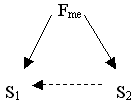
|
Fme |
Mechanical Field of speed of coating fabric (Fast coating speed) |
Source of energy |
|
S1 |
Fabric to be coated |
Recipient of the systems action - Product |
|
S2 |
Coating assembly |
Means by which energy is applied to the fabric - Tool |
The function of the system is to apply coating to the fabric at an increased speed via the coating assembly.
The SU-Field model above describes that the coating assembly has an insufficient effect of the fabric to be coated at an increased coating speed.
5.2. Try to solve the problem with SU-Field Model from step 5.1 using SU-Field Transformations:
The typical solution is proposed through use of the SU-Field Transformations:
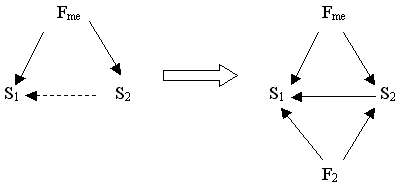
5.3. Render the initial SU-Field Model for the Problem on step 4.2, for which purpose:
IC-2: If the coating assembly is run at a slower than normal speed, then (+) the lower coating weight can be eliminated but (-) the production rate will drastically decrease.
SU-Field Model for Problem on step 4.2:
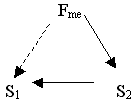
|
Fme |
Mechanical Field speed of coating fabric (Slow coating speed) |
Source of energy |
|
S1 |
Production Rate |
Recipient of the systems action - Product |
|
S2 |
Coated Fabric |
Means by which energy is applied to the fabric - Tool |
The function of the system is to apply coating to the fabric at a decreased speed via the coating assembly.
The SU-Field model above describes that the slow coating speed has an insufficient effect on the fabric. Coated fabric production rate goes to near zero.
5.4. Try to solve the problem with SU-Field Model from step 5.3 using SU-Field Transformations:
The typical solution is proposed through use of the SU-Field Transformations:

The selective maximum effect that is required for IC-2 is slow coating speed and should be maximum to produce the high production rate but at a minimum when coating the fabric so that a good coating weight can be obtained. The minimal field is the slow coating speed effect.
This promotes an idea that you get an effect at the coating assembly that prints as though the coating process is slow but the added substance still provides a high production rate. This is the same type of idea generated in the SU-Field model for IC-1. A connection can be made where the system move fast but coat the fabric as if it is moving slow.
Physical Contradiction Theory:
At this stage in the algorithm, I can see how this engineering problem can also be stated as a Physical Contradiction.
Physical Contradiction: The process must be both fast and slow at the same time.
Separation Within a Whole Object and Its Parts: I believe that the solution for this Physical Contradiction would be found using the Separation Within a Whole Object and Its Parts principle. The fabric must pass through the production line at a high speed to achieve the high production rate but when the fabric gets coated, it must run through a slower process to achieve a good coating weight. The coating process could be looked at very closely at the slow speed and may somehow be duplicated at the fast speed. It sounds as though the time may play an important factor in solving this problem.
5.5. If the Conflict Enforcement IC-2 on step 4.2 leads to disappearance or inactivity on the Useful Function Tool, render the appropriate SU-Field Model:
When IC-2 Conflict is enforced, it leads to a disappearance or inactivity on the Useful Function Tool:
S1 and S2 stand alone with no interaction
The system is incomplete and no production is made. No field is present to have interaction between the Production Rate and the Fabric.
5.6. Try to solve the problem with SU-Field Model from step 5.5 using SU-Field Transformations:
A field is needed to complete the incomplete system:

It is not known at this time what this proposed field may be.
6. Operational Zone Analysis and Resources Discovering
6.1. Determine the Operational Zone (OZ):

Picture 1. Descriptive Picture of Coating Process
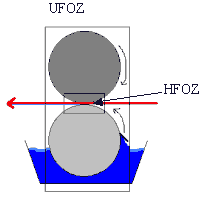
Picture 2. Textile Kiss-Coat Operation. Useful Function Operational Zone (UFOZ = Increased Speed of coating assembly. Harmful Function Operation Zone (HFOZ = Decreased coating weight) determined and labeled in process
The Useful Zone of the process is the properly coated fabric produced at an increased coating assembly speed, which in turn provides an increased production rate.
The Harmful Zone of the process is when not enough coating is transferred to the fabric at an increased coating speed. This happens at the contact point between the rubber nip roll and the gravure print roll.
In Figure 2 above, the UFOZ and HFOZ coincide and the Operational Zone of conflict is where the fabric is coated (HFOZ).
6.2. Determine the Operational and Resource Time (OZ and RT):
Time Diagram of the Technological System
|
Fabric moves into coating assembly and coating mix in coating assembly trough |
Resource Time |
|||
|
Coating head in motion and picks up coating |
Operating Time for Useful Function (+) |
|||
|
Fabric in contact between rubber and print rolls |
Operating Time for Harmful Function (-) |
Operational Time of Conflict (+ and -) |
||
|
Coating is transferred to fabric |
||||
|
Fabric leaves coating assembly |
6.3. Show on the Picture 2 and write out all substances and field existing in the both Useful Function Operational Zone (UFOZ) and Harmful Function Operational Zone (HFOZ) during Operational Time of both Useful and Harmful Functions (UFOT and HFOT) and during Resource Time. Indicate the properties and states of these substances and field associated with performing of both Useful and Harmful Functions. Indicate connections between these substances and fields:
Fields and Substances in UFOZ:
Fields and Substances in HFOZ:
States of objects in Resource Time:
6.4. Show on the Picture 1 and describe:
The coating assembly is filled with coating mix and the gravure print roll is turned on. As the gravure roll turns, the cells within the print roll collect the coating mixture that is located within the trough. The doctor blade then wipes excess coating from the surface of the roll leaving the coating that is within the cells. The fabric then passes over then print roll as the rubber roll is brought down via air pressure pistons. As the fabric is pressed between the rubber roll and the print roll with its cells filled with coating mixture a slight vacuum is created by squeezing the fabric. The fabric is then released from the pressure and the vacuum promotes the coating within the print cells of the gravure roll to be transferred onto the surface of the fabric. The fabric then leaves the coating assembly for drying. The system is in a continuous process and repeats itself without interruption.
6.5. Mark useful, harmful, insufficient and excessive substances, fields, properties, processes, flows.
|
Useful substances |
Coating mix, coating assembly rolls |
|
Useful fields |
Pressure from rubber roll, mechanical speed of coating assembly, vacuum created by nip pressure |
|
Useful properties |
Coating on fabric |
|
Useful processes |
Transfer of coating onto fabric |
|
Useful Flows |
Fabric moving through coating assembly |
|
Harmful substances |
None known at this time |
|
Harmful fields |
None known at this time |
|
Harmful properties |
Lightly coated fabric not wanted |
|
Harmful processes |
Slow coating speed leads to low production rate |
|
Harmful Flows |
Coating |
6.6. Draw the relative picture of events going on in the OZs during OT using the Smart Little Persons Model:
Using Smart Many Little People Modeling (MLP Modeling):
The Zone of Conflict:
The Zone of Conflict occurs only when the coating speed is increased. This takes form in that the fabric does not pick-up enough coating from the coating assembly at the increased speed.
MLP Model Utilization:
MLP is found to be extremely useful in this problem. The model can be depicted below as the MLP being on fabric whose job is to grasp the MLP on the print roll in the form of the coating mix in the print cells filled with MLP looking to leave the print roll and grasp the MLP on the fabric. This would transfer the coating MLP to the fabric MLP.
Initial Model: The fabric people represent sites where the coating people can attach themselves to by letting the fabric people pull the coating people out of there cells.

At a slow coating speed, the fabric people have enough time to grasp the coating people as can be seen in the following model:

The “Was” Model: In the “was” model, the coating speed has been increased and the fabric people cannot grasp all the coating people. Therefore some of the coating people are left inside their cells as displayed in the following picture:

The “Should Be” Model: This model should be the same as when the coating speed is lowered but we are coating at a faster coating speed:

Technical Solutions for the MLP Model:
Solution 1: The current scenario is that that fabric is moving too fast for the fabric people to grasp onto the coating people. This implies that there is a time constraint present due to the increase in coating speed. This constraint was not present when the coating speed was reduced because the coating on the fabric was not reduced. The solution to get to the “should be” model at a fast coating speed is to increase the time that the fabric people and coating people have together so that the fabric people will have time to grasp onto the coating people. Since the coating speed cannot be lowered to allow for this, it must me accomplished in another way.
The MLP modeling allows for a closer look at the situation. The contact time that the MLP have with each other can be determined by measuring the contact area between the rubber roll and the print roll (at the nip point). It is this contact area that must be increased to make up for the decrease in time lost when the coating speed was increased. The contact time and area are also known in the field as dwell time. So the dwell time between the two sets of MLP must me increased so that coating transfer can occur.
A softer rubber roll will increase this dwell time between the MLP and should allow for the coating MLP to be grasped by the fabric MLP. The softer rubber will provide for contact area when in contact (under pressure) with the gravure print roll.
Solution 2: The fabric MLP people could be enhanced to become better able to grasp the coating MLP when passing by at a fast speed. Adding a re-wetting agent to the fabric prior to the coating operation may do this. This re-wetting chemical agent would give the fabric additional wet-out properties that may increase the fabric’s MLPs to grasp the coating MLP.
Solution 3: Lowering the coating mix viscosity will help the coating MLP to move more freely from there cells. This may help the fabric MLP to pull the coating MLP from the cells more effectively even though the dwell time that they have would still be decreased. It should be noted however that if the viscosity is reduced, the % solids in the coating mix should not be lowered because it will add to lowering the final coating weight.
Conclusions:
The input from the Technical Contradiction Matrix Theory, SU-Field Analysis, Physical Contradiction Theory, and MLP modeling has solved the engineering contradiction presented in the introduction to this paper. I do not feel that completing sections 7 through 11 of ARIZ-85C is necessary. I have had the opportunity to apply what I have learned using ARIZ-85C with real problem. I am glad to say that I have been able to apply Solution 1 from the MLP modeling in a real life situation where I work. It should also be noted that Solution 1 from MLP modeling also ties into the Technical Contradiction Matrix Theory, SU-Field Analysis, and Physical Contradiction Theory. The outputs from these tools have let to the idea of compensating for the increase in coating speed by matching the coating dwell time that was achieved at the slow coating speed.
Although I do not think that this solution is a very innovative solution, it was a real problem that was solved using TRIZ tools. The tools provided a method to see through the physiological inertia that was actually present in my work environment.
As stated before, this problem initially started off as an administrative problem in that the coating line was running at 30 yds./min. and there was little understanding as to why the coating weight was so low. It was known that the coating weight must be increased and the speed was not thought to play a role. I did not have much experience on the production line or this particular coating process. I was able to provide an outside view of what may be happening. This outside view also allowed me to be free of much of the psychological inertia that others had by working on the problem. I also owed a great deal to what this class has taught me.
I proposed that a study of line speed versus coating weight be performed because it was the easiest variable that we had control over. The results can be found below in Figure 3 below.
From the results of this study, it became clear what the real problem was. It was a technical contradiction in that when the line speed was increased, the coating weight decreased. I therefore decided that I would use this as my major project for TE 589A.
I applied Solution 1 from the MLP modeling found in Section 6.6 by replacing the 90 hardness (Shore A) rubber roll with a 60 hardness (Shore A) softer rubber roll. We were looking for a total coating weight of approximately 2.50 oz./yd2. Our results before the rubber roll change were around 2.35 oz./yd2 at 30 yds./min., which can be seen on Figure 3. The softer rubber roll idea from Solution 1 results can be seen in Figure 4.
A large increase in coating weight was achieved by using the softer rubber roll and MLP Solution 1 provided a means where the coating speed could be increased and the coating increased within specifications. The Engineering Technical Contradiction was resolved.
This problem is probably a level 2 for solution inventiveness, which is why the full completion on ARIZ may have been too much since ARIZ is usually used to solve hard (possibly level 4 or 5) inventive problems. However, as a new practitioner of TRIZ methods, ARIZ systematically guided me through the problem solving process.
Even though my primary academic training is Textile Chemistry, following the systematic approach to apply TRIZ methods enabled me to identify a mechanical solution that solved my problem. Although the solution may have been one identified by a mechanical engineer, I was able to "look" in a new direction for solutions.
TRIZ methods and practices I have learned in this class have changed the way I tackle problems in my everyday work related situations. I will continue to use this method whenever possible.
The following book and articles were found to especially useful in learning and applying the TRIZ methods used in this paper:
APPENDIX A
Spring 2000 TE589A: Theory of Inventive Problem Solving
Survey Summary
Dr. Michael S. Slocum, Dr. Timothy G. Clapp